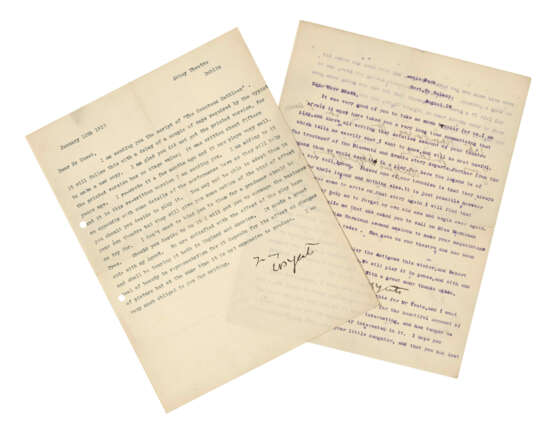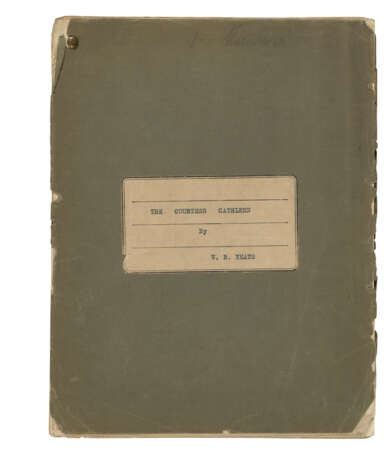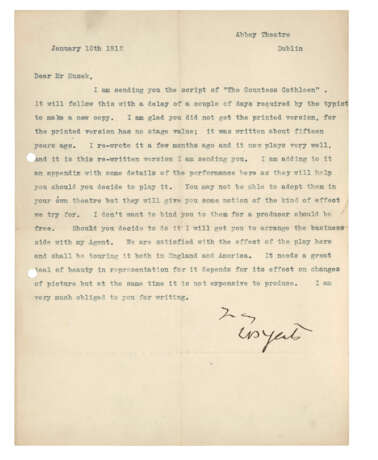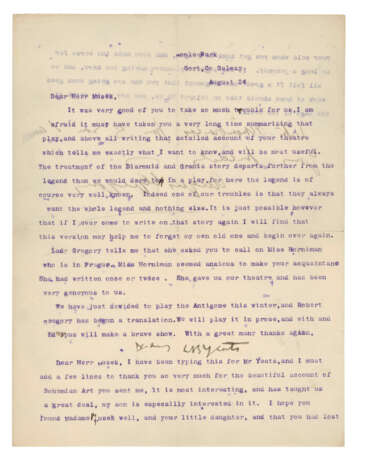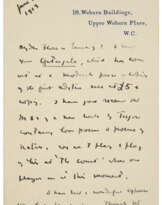ID 1108993
Lot 193 | William Butler Yeats (1865-1939)
Estimate value
£ 4 000 – 6 000
Typescript signed ('W.B. Yeats') of The Countess Cathleen with extensive autograph annotation, the typescript c.1912, the annotation 13 August 1929
64 pages, 265 x 205mm, paginated '[1]-61', text on rectos only, stabbed at top and attached with brass pin, Yeats's annotation on the title, the same page also with an annotation signed by Augusta, Lady Gregory. Grey paper covers. With two typed letters signed to [Karel] Mušek, Abbey Theatre and Coole Park, 10 January 1912 and 24 August n.y., the second also signed by Lady Gregory. Provenance: James Gilvarry (1914-1984) – his sale, Christie's New York, 7 February 1986, lot 551.
Contemporary typescript signed of Yeats's verse drama on Irish famine and the redemption of a soul. Yeats's letter to Karel Mušek of 10 January 1912 refers to the typescript, which he is about to send him: 'I am glad you did not get the printed version, for the printed version has no stage value: it was written about fifteen years ago. I re-wrote it a few months ago and it now plays very well ... We are satisfied with the effect of the play here ... It needs a great deal of beauty in representation for it depends for its effect on changes of picture'. The incompletely dated letter thanks Mušek for summarising a play on the Irish legend of Diarmuid and Grania (the subject of a play co-written by Yeats and George Moore in 1901), whose treatment 'departs further from the legend than we would dare to in a play ... one of our troubles is that they always want the whole legend and nothing else'. Yeats's 1929 annotation on the typescript remembers Mušek: 'a vivid, energetic man, a producer & actor ... He came to Ireland in 1912, I think, to get the right local colour for his productions of Irish plays ... He stayed at Coole Park, in Co. Galway – Lady Gregory's house ... I think that Musek's visit was the first important sign that our movement was recognised on the continent'.
Karel Mušek (1867-1924) was a Czech actor and theatre producer, who translated a number of Irish plays for performance at the Bohemia National Theatre in Prague. Yeats's first version of his verse drama The Countess Cathleen dates from 1892 and was first performed in 1899: it was later radically revised before the present, final version, which was first performed at the Abbey Theatre on 14 December 1911.
| Artist: | William Butler Yeats (1865 - 1939) |
|---|---|
| Place of origin: | Ireland, United Kingdom |
| Artist: | William Butler Yeats (1865 - 1939) |
|---|---|
| Place of origin: | Ireland, United Kingdom |
| Address of auction |
CHRISTIE'S 8 King Street, St. James's SW1Y 6QT London United Kingdom | |||||
|---|---|---|---|---|---|---|
| Preview |
| |||||
| Phone | +44 (0)20 7839 9060 | |||||
| Buyer Premium | see on Website | |||||
| Conditions of purchase | Conditions of purchase |
